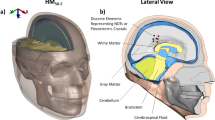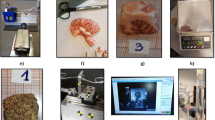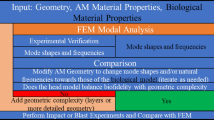Abstract
This research focused on correlating the macroscopic blunt impact conditions to the internal pressure developed in the coup and contrecoup regions for water and gelatin-filled surrogate human head models. Obtaining a relationship between bulk acceleration and localized internal pressure of a human head surrogate will allow for correlation to the damage done on tissue level length scales. Internal pressure information also allows for investigation into the possibility of cavitation inside the head phantom, a potential damage mechanism for TBI. Two separate 3D printed head models were studied: the coronal model simulates a frontal impact and the sagittal simulates a side impact. A dynamic impacting test platform was designed and manufactured in-house to deliver varying controlled impact conditions. The coup and contrecoup are the measured regions of interest due to the potential for the highest magnitude pressure spikes. A range of experiments were performed measuring the resulting bulk acceleration and internal fluid pressure response over varying impact velocities for both water and gelatin filled surrogates. The experimental results were compared with an ANSYS Explicit Dynamics simulation. The resulting pressure in the coup and contrecoup region are recorded for varying impact velocities. The experiment shows that at the maximum impact velocity of 5.5 m/s in the frontal impact of the water filled model, the coup pressure is approximately + 96 kPa while the contrecoup is – 47.3 kPa. The finite element model shows reasonably good agreement with the coronal experimental results for the 5.5 m/s impact condition with a coup pressure of + 102 kPa and a contrecoup pressure of – 68 kPa.















Similar content being viewed by others
Data availability
Raw data and analyzed data can be made available upon request.
References
M. James, P. Kelly, Traumatic brain injury and concussion in sports. JAMA 282, 989–991 (1999)
L. Zhang, K.H. Yang, A.I. King, A proposed injury threshold for mild traumatic brain injury. J. Biomech. Eng. 126(2), 226–236 (2004). https://doi.org/10.1115/1.1691446
K. Brolin, Correlation of global head and brain tissue injury criteria to experimental concussion derived from monkey head trauma experiments, 2013. [Online]. Available: https://www.researchgate.net/publication/287756456
R. Saunders, N. Kota, A. Bagchi, S. Qidwai, On challenges in developing a high-fidelity model of the human head for traumatic brain injury prediction (2018)
R.M. Wright, A Computational Model for Traumatic Brain Injury Based on an Axonal Injury Criteria (2012)
R.J.H. Cloots, J.A.W. van Dommelen, S. Kleiven, M.G.D. Geers, Multi-scale mechanics of traumatic brain injury: predicting axonal strains from head loads. Biomech. Model. Mechanobiol. 12(1), 137–150 (2013). https://doi.org/10.1007/s10237-012-0387-6
A. King, K. Yang, L. Zhang, Is Head Injury Caused by Linear or Angular Acceleration? Injury predictors for traumatic axonal injury in a rodent head impact acceleration model View project Projects in impact biomechanics View project, 2003. [Online]. Available: https://www.researchgate.net/publication/242211067
B. Thorne, Pendulum Based Impact Testing of Athletic Helmets Using the NOCSAE Headform, 2016. [Online]. Available: https://digitalscholarship.unlv.edu/thesesdissertations/2907
A. Singh, S.G. Ganpule, M.K. Khan, M.A. Iqbal, Measurement of brain simulant strains in head surrogate under impact loading. Biomech. Model. Mechanobiol. 20(6), 2319–2334 (2021). https://doi.org/10.1007/s10237-021-01509-6
J. Goeller, A. Wardlaw, D. Treichler, J. O’Bruba, G. Weiss, Investigation of cavitation as a possible damage mechanism in blast-induced traumatic brain injury. J. Neurotrauma 29(10), 1970–1981 (2012). https://doi.org/10.1089/neu.2011.2224
P.G. Young, An analytical model to predict the response of fluid-filled shells to impact - a model for blunt head impacts. J. Sound Vib. 267(5), 1107–1126 (2003). https://doi.org/10.1016/S0022-460X(03)00200-1
P.G. Young, C.L. Morfey, Intracranial pressure transients caused by head impacts
A.M. Nahum, R. Smith, C.C. Ward, Intracranial pressure dynamics during head impact (2018)
M.D. Gilchrist, The creation of three-dimensional finite element models for simulating head impact biomechanics (2003)
F. Hasan, K.A.H. Al Mahmud, M.I. Khan, S. Patil, B.H. Dennis, A. Adnan, Cavitation induced damage in soft biomaterials. Multiscale Sci. Eng. 3(1), 67–87 (2021). https://doi.org/10.1007/s42493-021-00060-x
A. Jackson, A. Adnan, Internal Pressure Response of a Human Head Surrogate Model Subject to Variable Impact Loading with Finite Element Analysis, Master of Science Aerospace Engineering, University of Texas at Arlington, Arlington (2021)
V.S. Caviness, D.N. Kennedy, C. Richelme, J. Rademacher, and P.A. Filipek, The Human Brain Age 7–11 Years: A Volumetric Analysis Based on Magnetic Resonance Images. [Online]. Available: https://academic.oup.com/cercor/article/6/5/726/497980
S.J. RUAN, Impact Biomechanics of Head Injury By Mathematical Modeling (1994)
Using two tri-axis accelerometers for rotational measurements, 2015. [Online]. Available: www.kionix.com
S. Budday et al., Mechanical properties of gray and white matter brain tissue by indentation. J. Mech. Behav. Biomed. Mater. 46, 318–330 (2015). https://doi.org/10.1016/j.jmbbm.2015.02.024
A. Markidou, W.Y. Shih, W.H. Shih, Soft-materials elastic and shear moduli measurement using piezoelectric cantilevers. Rev. Sci. Instrum. (2005). https://doi.org/10.1063/1.1928407
F. Wang et al., Prediction of brain deformations and risk of traumatic brain injury due to closed-head impact: quantitative analysis of the effects of boundary conditions and brain tissue constitutive model. Biomech. Model. Mechanobiol. 17(4), 1165–1185 (2018). https://doi.org/10.1007/s10237-018-1021-z
Ansys Explicit Dynamics Analysis Guide, 2022. [Online]. Available: http://www.ansys.com
Y.C. Chen, T.J. O’Shaughnessy, G.H. Kamimori, D.M. Horner, M.J. Egnoto, A. Bagchi, Role of interfacial conditions on blast overpressure propagation into the brain. Front. Neurol. (2020). https://doi.org/10.3389/fneur.2020.00323
W. Kang, A. Ashfaq, T. O’shaughnessy, A. Bagchi, Cavitation nucleation in gelatin: experiment and mechanism. Acta Biomater 67, 295–306 (2017)
A. Wardlaw, J. Goeller, Cavitation as a possible Traumatic Brain Injury (TBI) damage mechanism. In: IFMBE Proceedings, 2010, vol. 32 IFMBE, pp. 34–37. https://doi.org/10.1007/978-3-642-14998-6_9
L. Zhang, K.H. Yang, A.I. King, Comparison of brain responses between frontal and lateral impacts by finite element modeling. J. Neurotrauma 18(1), 21–30 (2001). https://doi.org/10.1089/089771501750055749
K. Baeck, J. Goffin, J. vander Sloten, The use of different CSF representations in a numerical head model and their effect on the results of FE head impact analyses (2011)
MatWeb Material Property Data: Nylon 12. https://www.matweb.com/search/DataSheet.aspx?MatGUID=0e37a459c4eb452faa9d92659f9a0ccc. Accessed 16 Dec 2022
HP 3D High Reusability PA 12,” 2017. https://www.forecast3d.com/materials/mjf. Accessed 16 Dec 2022
NinjaTek Technical Specs, 2022. https://ninjatek.com/support/technical-specs/. Accessed 16 Dec 2022
A. Koster, A. Adnan, Relating linear and rotational accelerations with internal pressure response developed inside human head surrogate models, Master of Science Aerospace Engineering, University of Texas at Arlinngton, Arlington (2021)
M.B. Panzer, B.S. Myers, B.P. Capehart, C.R. Bass, Development of a finite element model for blast brain injury and the effects of CSF cavitation. Ann. Biomed. Eng. 40(7), 1530–1544 (2012). https://doi.org/10.1007/s10439-012-0519-2
W.C. Moss, M.J. King, E.G. Blackman, Skull flexure from blast waves: A mechanism for brain injury with implications for helmet design. Phys. Rev. Lett. (2009). https://doi.org/10.1103/PhysRevLett.103.108702
A.P. Bowling, Vector Mechanics: A Systematic Approach, Third Edition
Acknowledgements
This work has been funded by the Force Health Protection (FHP) program through the Office of Naval Research (ONR) (Award # ONR: N00014-21-1-2051 and ONR: N00014-19-1-2383: Dr. Timothy Bentley, Program Manager).
Funding
Office of Naval Research, N00014-21-1-2051, Ashfaq Adnan, N00014-19-1-2383, Ashfaq Adnan.
Author information
Authors and Affiliations
Contributions
AJ and AK made equal contributions. Both contributed to the conceptualization, methodology, software, finite element analysis, validation, building of experimental setup and data acquisition system, investigation, and writing—original draft. FH: finite element analysis and design of data acquisition system and model. AA: initial conceptualization, methodology, validation, writing—review & editing, funding acquisition.
Corresponding author
Ethics declarations
Conflict of Interest
The authors have no competing interests or conflict of interests.
Additional information
Publisher's Note
Springer Nature remains neutral with regard to jurisdictional claims in published maps and institutional affiliations.
Appendices
Appendix
Experimental Setup
(See Fig. 16).
Mesh Convergence Study
A mesh convergence study was performed for both the coronal and sagittal plane models. Several simulations were run using the 80-degree impact conditions while varying element size from 14 to 3 mm. Figure 17a and b shows the maximum pressure developed in the coup and contrecoup region for the coronal and sagittal models, respectively. As the element count was increased the recorded pressure in the regions of interest was tracked until convergence was assumed within an acceptable tolerance of 5%. For the coronal model, the mesh was assumed to converge at an element size of 3 mm. For the sagittal model, the mesh size was assumed to have converged for an element size of 4 mm. The simulation time for the coronal model took 63 min. The time for one sagittal simulation to complete was 28 min. The approximate times that each simulation took for the respective element size are included in Fig. 17a and b.
Characterization of Dynamic Test Platform
The characterization of the impacting test platform is necessary for correlation of the impact conditions to the developed internal pressure. It is also important for the proper representation of the initial conditions for the FEM model. Using rigid body dynamics, the mass and inertia properties for both the pendulum arm and the impact ball can be considered and included in the formulation of the equation of motion. Solving the equation of motion for the acceleration and velocity at the position of the impact ball will give all necessary input parameters for the study. Figure 18 gives a schematic of the test platform containing the two rigid bodies.
Half the length of the pendulum arm is\(L=0.4572 m\). Body A has a mass of 2.4 kg and an inertia\({I}_{z{z}_{A}}=0.49 kg{m}^{2}\). Body B has a mass of 0.22 kg and an inertia of\({I}_{z{z}_{B}}=1.2*{10}^{-4} kg{m}^{2}\). The generalized active forces and inertia forces are given by Eqs. (8) and (9), respectively. Kane’s method is given by Eq. (10) and is developed from Euler’s First and Second Laws with consideration of the total work done on the system [35].
Using the above equations, the equation of motion for the system is derived as shown in Eq. (11).
A rigid body dynamics simulation software called Autolev was used to solve the equation of motion for the position, velocity, and acceleration of body B for initial conditions \({q}_{1}={20}^{^\circ }\) to \({q}_{1}={80}^{^\circ }\) in increments of \({10}^{^\circ }\). The acceleration and velocity of the impact ball were calculated at the moment of impact when \({q}_{1}={0}^{^\circ }\). To verify the dynamic simulation, digital image correlation (DIC) was utilized with a Photron FASTCAM high-speed camera. For each system initial condition, a high-speed video was taken of the impact ball at the moment of impact (\({q}_{1}={0}^{^\circ }\)). The results of the rigid body dynamics simulation and the high-speed camera DIC analysis are shown in Fig. 19 [25].
The rigid body dynamic simulation and the DIC agree well with one another. At drop angels of 20°, 40°, 70°, and 80°, the calculated velocity is within 4% of the observed value. The largest difference is at a drop angle of 60° where the calculated value is within 9% of the observed value. Discrepancies in the impact velocity can be attributed to errors associated with the digital angle measure device.
Rights and permissions
Springer Nature or its licensor (e.g. a society or other partner) holds exclusive rights to this article under a publishing agreement with the author(s) or other rightsholder(s); author self-archiving of the accepted manuscript version of this article is solely governed by the terms of such publishing agreement and applicable law.
About this article
Cite this article
Jackson, A., Koster, A., Hasan, F. et al. Impact Testing of a Surrogate Human Head Model for Correlation of Bulk Acceleration to Intracranial Pressure. Multiscale Sci. Eng. 5, 35–52 (2023). https://doi.org/10.1007/s42493-023-00090-7
Received:
Revised:
Accepted:
Published:
Issue Date:
DOI: https://doi.org/10.1007/s42493-023-00090-7








